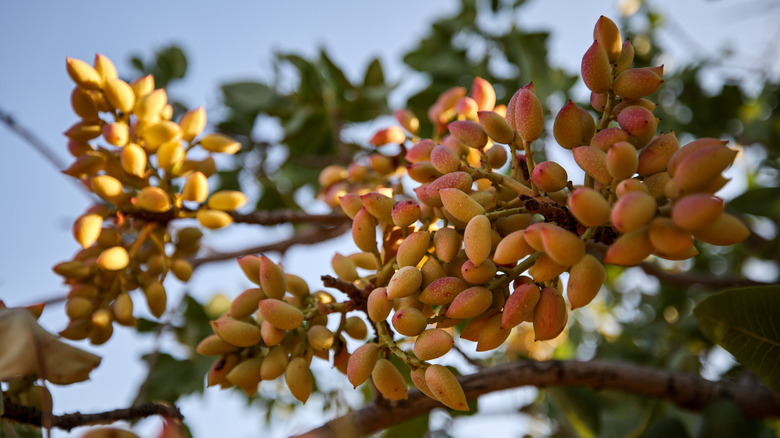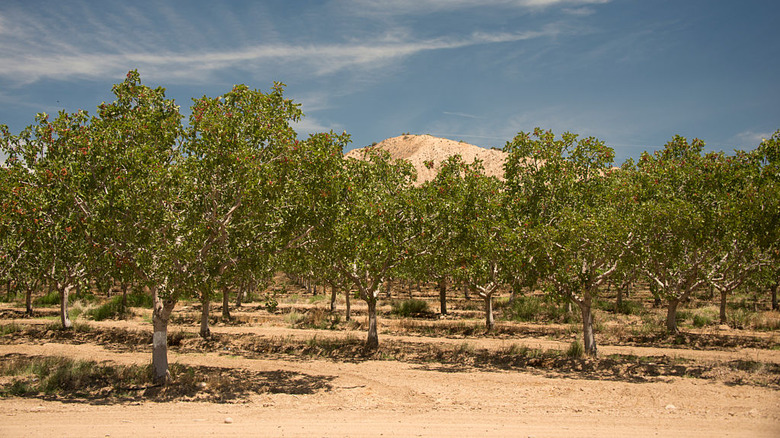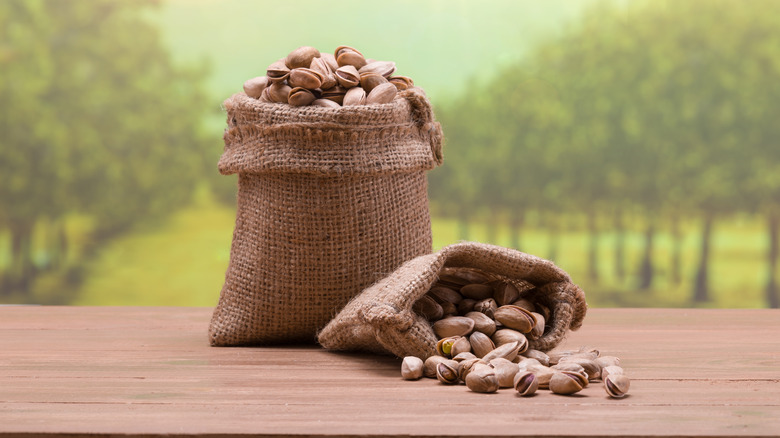Here's Where Pistachio Trees Grow Best (& Tips To Ensure A Tasty Harvest)
Pistachios are mouthwatering and nutritious nuts with numerous culinary uses — and a steep price tag. But if you're lucky and persistent, you may be able to grow a pistachio tree at home and enjoy your own harvests of its prized nuts. However, your location is paramount. Pistachios trees demand very specific climatic conditions to produce nuts. According to American Pistachio Growers, all commercially produced nuts come from New Mexico, California, and Arizona. Only these states have the right climate for growing these trees and getting bountiful harvests.
But even with the right weather year-round, pistachio trees need lots of work and patience on your part to bear nut-filled fruit. Some of these demands can be taxing. For example, you may struggle to balance meeting the watering requirements of these trees in the hot season and effectively keeping excessive moisture away from the roots and foliage. Even the harvests take careful planning and execution. Without it, you risk a year's worth of effort succumbing to fungal growths and other pests. But where there's a will, there's a way. If you live in a pistachio-friendly region and are willing to spoil your trees with love, you stand to have an annual supply of delicious nuts in your pantry. Below, you'll learn how to care for them.
Best conditions for growing pistachio trees
Pistachio trees thrive in the U.S. Southwest. Of the three states, California is the most significant producer because parts of it boast a favorable climate for pistachio production. The trees are quite finicky about their temperature and humidity needs, and these vary wildly between seasons. Pistachio trees do their best in hot, arid summers. However, come winter, their preference shifts to cooler weather. From November until March, pistachios require nearly 900 hours of temperatures under 45 degrees Fahrenheit and can tolerate dips around 27 degrees Fahrenheit. This prolonged chill promotes consistent blooming in pistachio trees once they exit dormancy after winter. California's Central Valley is far enough from the moderating influence of the ocean to satisfy such diverse climate needs.
Despite their preference for hot, dry weather, pistachio trees need quite a bit of water during the year's hottest months. To produce a quality harvest of nuts, each tree's daily water intake should reach as much as 50 gallons! With this much water, proper drainage is a must to avoid harming the trees. Apart from their summertime thirst, pistachios also prefer a specific soil type. Loamy, evenly-textured soils with clay, sand, and humus make the ideal habitat for this tree. That said, the trees will adapt to various soil conditions as long as they drain well.
How to get the tastiest pistachio nuts every harvest
If you've decided to grow a pistachio tree on your property, a few best practices will ensure their kernels end up with nuts at harvest time. Job one is to correct the trees' inherent zinc, boron, and copper deficiency with a foliar spray comprising these three minerals. Adequate fertilization to meet your garden's needs is of equal importance. Nut-producing pistachio trees should receive a total of 5 pounds of ammonium sulfate fertilizer during the growing season, from July to the end of August. While generous watering is vital for quality harvests, your home garden irrigation system shouldn't get water on the trees' foliage — doing so can sicken the leaves.
Harvesting pistachio nuts is a delicate process, too. Timely harvests are crucial, and you should be knocking the nuts from the branches as soon as they turn orange. Waiting any longer will leave you sharing the harvest with birds and insects. And since the freshly gathered nuts are vulnerable to fungus, you'll have to take precautions while harvesting and immediately after. Before you knock the nuts from the tree, spread a clean tarp underneath to prevent contact with soil, which can infect the nuts. Next, dry the nuts right away to prevent fungal disease from attacking their hulls.


